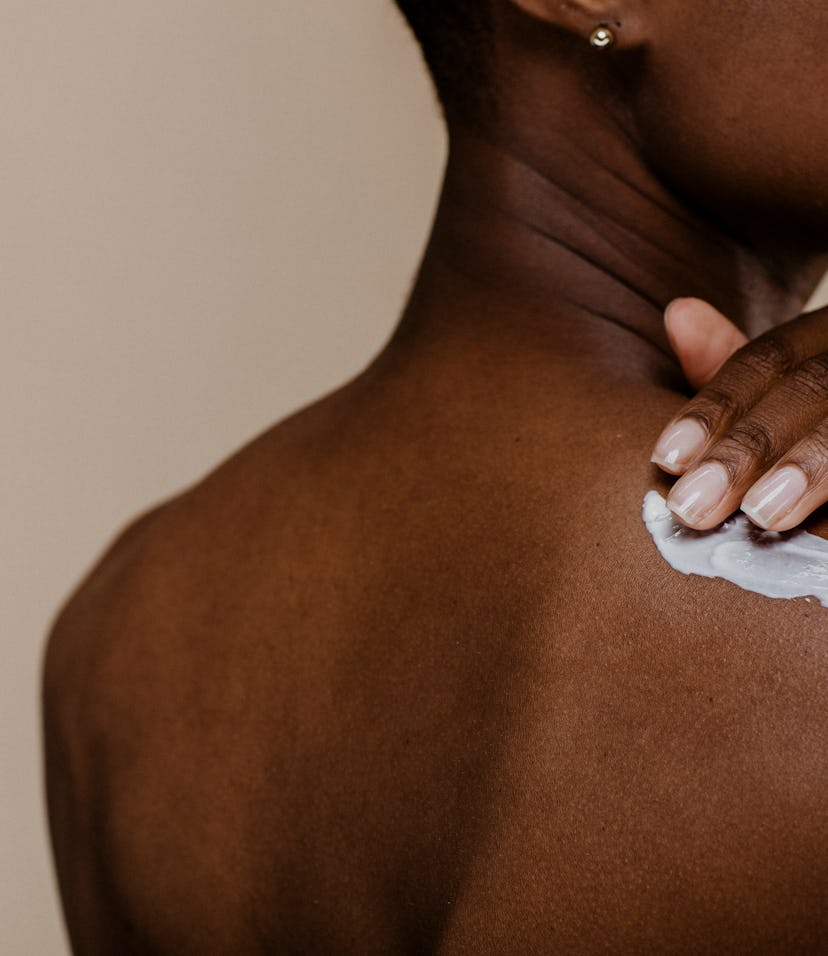(Skin)
Make An At-Home Body Peel Your Next Self-Care Sunday Activity
The real deal on body peels.

Remember when an at-home spa day consisted of a face mask, a DIY mani-pedi, and maybe a bubble bath, complete with a lit candle? Today’s self-administered beauty treatments are decidedly more extravagant. You can book an in-home massage through an app, give yourself a spa-level acid facial, and even reach for a portable spray tan machine to get glowing, all in the course of a single #SelfCareSunday. Now, there’s one more treatment to add to your weekend to-do list: an at-home body peel. Much like facial peels, body peels rely on chemical exfoliation from ingredients like salicylic, trichloroacetic, lactic, and glycolic acids to improve skin tone and texture from neck to toe. Upon application, these acids break down the bonds between dead skin cells, effectively “peeling” away a layer of dead skin.
“The face is the most common location for chemical peels, but the rest of the body endures similar damage over time,” Dr. Duane Dilworth of DTLA Dermatology in Los Angeles tells TZR. “Chemical body peels are an effective procedure to help refresh and rejuvenate the skin.” Just think of them as full-body facials.
What Do Body Peels Do?
Traditionally, most skin care products have been targeted for the face, but that trend is turning thanks to the rise of luxe body care brands like Soft Services, Néccessaire, and Kate McLeod. That means more options to treat the skin on the rest of your body. Body peels especially (which you can also book at a spa if you’re not the do-it-yourself type) can help reduce body acne, wrinkles, and rough patches; or just make you feel significantly smoother and softer.
“At-home body peels are becoming popular for the same reason at-home facial peels are popular,” Dr. Amy Taub of ADV Dermatology in Chicago says. “To enable exfoliation and renewal, and to make skin look smoother and more radiant.” In addition, these treatments can prevent ingrown hairs and prep the skin for an even application of self-tanner. So how does it work, exactly?
Body Peel Side Effects
“Chemical peels are categorized by their depth, ranging from light to deep,” Dr. Dilworth explains. “Generally speaking, light chemical peels have the lowest risk of side effects. These include lower percentages of glycolic acid, salicylic acid, lactic acid, and TCA.”
Light chemical peels are categorized as those with an under 5% acid concentration. These low doses may still give you a tingling or burning sensation (which makes sense: You're literally burning off a layer of dead skin with acid), but that's to be expected. Depending on the treatment, the tingling should subside once you wash the product off, but your skin may be sensitive for another day or so. Mid and deep-level treatments, however, have the potential to leave you with red, sensitive skin for days or even weeks. Dr. Dilworth recommends proceeding with caution when applying peels with higher concentrations of acids.
The main risk with all chemical exfoliators is over-exfoliation. “That could lead to irritation or outright burning and subsequent scarring or infection,” Dr. Taub cautions. To avoid over-exfoliation, don’t perform a chemical peel directly before or after physical exfoliation (like dry brushing or using a body scrub), and don’t layer multiple acid-filled products on top of one another.
How Long Do Body Peels Take To Heal?
Even if you’re used to applying acid exfoliators on your face (looking at you, Biologique P50 fans), it’s important to note that the body is a completely different situation. “The skin on the body doesn’t heal as quickly or as well as facial skin," Dr. Taub says. “It could be more susceptible to problems with acids, even in the same concentration as a facial product.” Those with sensitive skin may want to try natural peels formulated with fruit enzymes (chemicals that break down proteins) instead of harsher acids. These enzymes function in pretty much the same way — loosening bonds between skin cells — but are way gentler, according to Self.
If you do decide to give at-home body peels a go, just remember that the skin takes approximately give to 10 days to heal (even after a low-dose peel). Leave at least two weeks’ time in between treatments, and follow with a generous application of moisturizer and SPF.
Ahead, 12 body peels to level up your next at-home spa day.
We only include products that have been independently selected by TZR's editorial team. However, we may receive a portion of sales if you purchase a product through a link in this article.
This article was originally published on